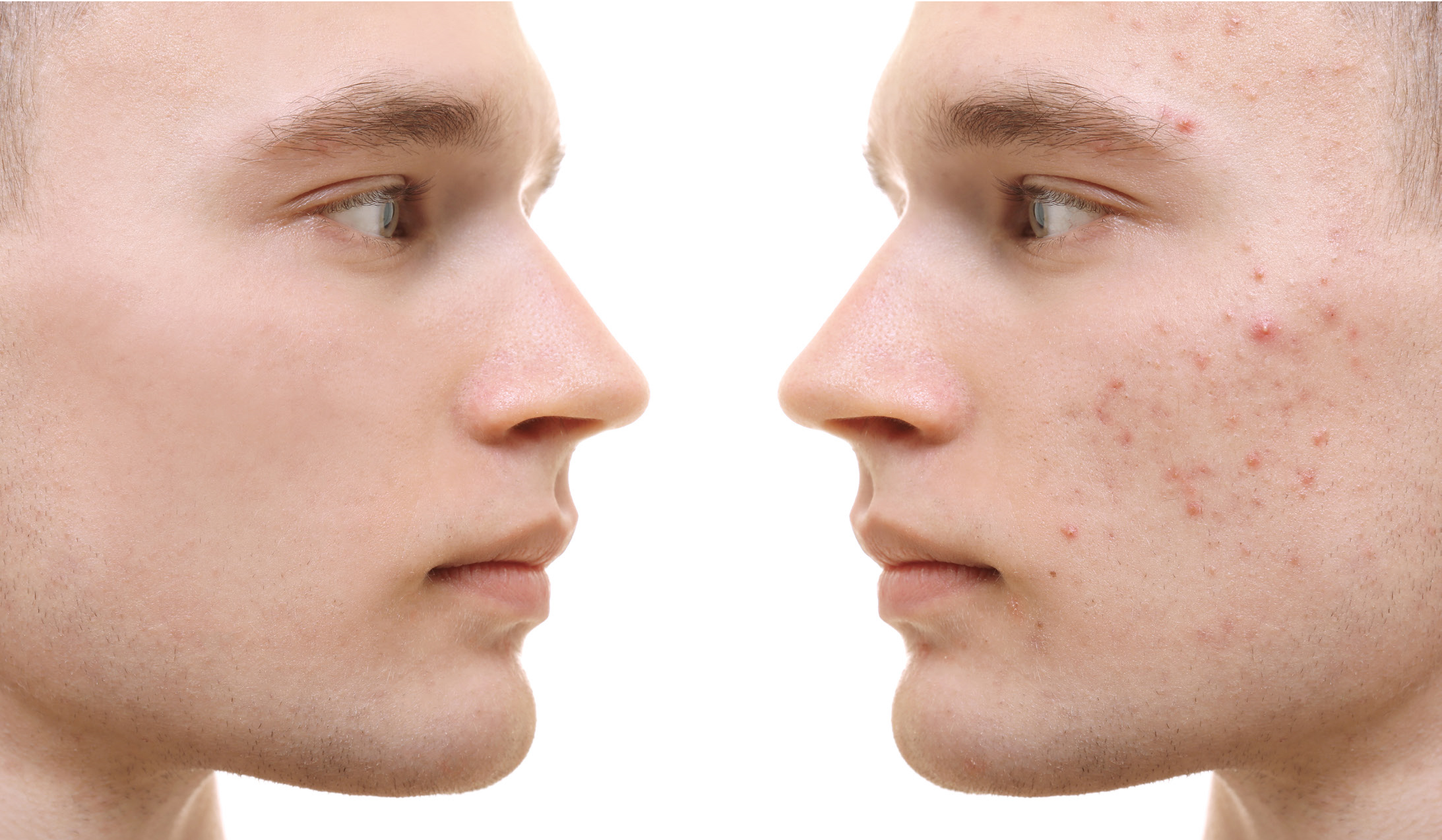
Acne is an extremely common dermatological condition and can present in a variety of manifestations. Often, the subject of acne is raised during consultations for aesthetic treatments that generally begin with a discussion about overall skin care. It can be surprising for clients when they have visited a practitioner for a certain procedure, only to be asked about their skin care regime. However, this is vital if practitioners are to provide holistic treatments to clients that are based on their identified needs.
Triggers and treatments
Plewig (2019) suggests that acne invariably begins in the early teens and, for this reason, can be considered to be one of the most common physiological manifestations of puberty. However, in some cases, acne can first present in the early twenties and thirties.
The inflammatory process may be one of the most important triggers for acne. Understanding the physiological process of inflammation to appreciate the role it plays in acne is important so the aesthetic practitioner can incorporate this information to provide treatments specifically suited to reducing inflammation. Therefore, the author suggests that acne should be considered a chronic inflammatory disease. However, more often than not, traditional treatments have focused on treating acne as an acute infection or an acute flare-up, rather than a chronic disease. In itself, this is complex. Dreno et al (2015) suggest that there are several physiological processes that lead to the inflammation, and that the inflammation is present in all acne lesions including comedones, inflammatory lesions, erythema and hyperpigmentation.
These factors include the production of sebum, which is usually stimulated by the release of specific hormones. Physiologically, the part of the skin affected is the pilosebaceous unit, which is comprised of the hair shaft, the hair follicle and the sebaceous gland. Di Caprio et al (2017) state that, during the increase in sebum production, there is a higher than normal number of interleukin-36 cytokines, which are part of the innate immune system. This group of interleukins includes pro-inflammatory interleukins that trigger an inflammatory response in the skin, as well as the release of natural receptor antagonists that increase the inflammatory response.
When there is inflammation of the sebaceous gland, this leads to the overproduction of sebum, a condition known as hyperseborrhoea. There are also changes to the fatty acid composition of the sebum. Therefore, it is a combination of these factors that lead to keratinisation of the pilosebaceous unit, formation of comedones and inflammatory lesions, post-inflammatory erythema or hyperpigmentation and scarring.
Going beyond the traditional approach
It is important to consider at this point that, traditionally, the approach to acne would be to focus on suppressing the effects of the condition, usually by the use of oral antibiotics, rather than taking into account its inflammatory process. Zaenglein (2018) suggests that a combination of a topical retinoid with its anti-inflammatory properties can be used in conjunction with benzoyl peroxide. A retinoid works by stimulating the proliferation and early death of skin cells to clear the skin and promote the growth of healthy tissue. Furthermore, this process helps to unblock the pilosebaceous unit, thus reducing the underlying infection and leading to fewer outbreaks of acne, as well as a potential reduction in scar formation. Benzoyl peroxide works in a similar manner as it increases cell turnover by exfoliating the skin and unblocking pores. There is also an argument for the inclusion of an oral antibiotic in cases considered to be moderate to severe and, often, this is oxytetracyclines, although macrolides are a suitable alternative. However, the use of antibiotics in acne, although considered a traditional approach, is still controversial. At this point, it is interesting to note that Sinnott et al (2016) argue that the use of oral antibiotics for acne as a mainstay treatment is outdated and potentially harmful. With antibiotic resistance on the rise, it is suggested that overuse in this area can be seen to be the ‘tip of the iceberg’.

Understanding the pathophysiology of acne
The previously mentioned approach to treatment is supported by Tahir (2016) who agrees that the main cause of acne is inflammation of the pilosebaceous unit. It is further stated that acne can be characterised by the formation of papules, pustules and cysts, with the most common area of presentation being the face, followed by the back and chest. Again, it is interesting to note that Tahir (2016) also supports the view that a good understanding of the pathophysiology of acne leads to improved outcomes. Many researchers are now focusing on the triggers of acne when, traditionally, acne has been treated with oral antibiotics as an acute infection. As previously suggested, there is now a shift away from the use of oral antibiotics as a first line treatment for acne. Indeed, Moradi Tuchayi et al (2015) suggest that there are many factors related to acne and its severity, including the inflammatory response, an increase in sebaceous gland secretion, increased proliferation of follicles, hormonal effects and bacterial colonisation. So, it is not a case of simply giving a patient oral antibiotics; the underlying pathophysiology needs to be understood by the practitioner and, often, this is lacking.
Acne and diet
While it has always been seen to be something of a traditional approach to the management of acne, there is evidence to suggest that there is a relationship between acne and dietary intake. Burris et al (2017) studied the dietary habits of males and females categorised as having no acne to severe acne and found that the subjects who had moderate to severe acne had significantly poorer diets, with little or no vegetable intake. This suggests that there is an association between poor diet and acne. From the practitioner's point of view, this can then be used as an opportunity to discuss healthy lifestyle and dietary intake as part of a holistic assessment of the individual. This approach is supported by Kulkarni et al (2016), who demonstrated that poor diet and dietary habits were found to be more prevalent in people with conditions such as acne and psoriasis when compared to control groups.
» The treatment provided for acne is not always the most effective or appropriate. It is fair to suggest that this should be taken into account when instigating the treatment regime «
Hormonal factors
Hormonal factors are also important in relation to acne. The hormones involved are androgens (testosterone and androstenedione) and Barros (2017) raises an important point that sudden onset of acne can be an indication of serious underlying endocrinopathies, such as polycystic ovarian syndrome, certain tumours and adrenal hyperplasia. It is important for the practitioner to possess an awareness of this. When acne is caused by hormonal imbalance or overproduction, specific medications, such as spironolactone (an androgen receptor blocker), can be used. Alternatively, ovarian blockers, such as the oral contraceptive pill, can be used to regulate and control acne. Pace (2015) further suggests that acne is a frequent clinical presentation of hyperandrogenism in endocrine disorders, such as polycystic ovary syndrome.
Furthermore, insulin resistance is another factor that can drive acne. Increased sugars make the client more susceptible to skin infections, with Pace suggesting that insulin-sensitising agents such as metformin can be used, as well as androgen blockers as previously suggested. However, insulin resistance is disputed by Balta et al (2015) whose research suggests that insulin resistance is not a major factor in acne, while factors such as hormonal changes, genetic factors, stress and the overuse of cosmetics should be considered in the treatment of acne. The suggestion that over-the-counter cosmeceutical products are actually harmful for the treatment of acne is very interesting and has a lot of implications for aesthetic practitioners. It raises the question of how often people with acne are seen to use over-the-counter (and, at times, expensive) cosmeceutical products that actually add little value and do little to help the condition. Often, these products are used on an ad-hoc basis, without any sort of supervision or monitoring, which leads to disappointment for the client and a poor outcome for the treatment of the underlying condition.
Treatment outcomes and expectations of treatment for acne should always be considered. Stein et al (2016) suggest that there are significant statistical differences between the treatment provided and the outcome for the patient. In other words, the treatment provided for acne is not always the most effective or appropriate. It is fair to suggest that this should be taken into account when instigating the treatment regime—the treatment has to be appropriate for patients to comply with it (for example, not many will want to comply with a painful treatment regime) and the outcomes have to be monitored to ensure it is effective.
At this point, the effect that acne can have on the self-esteem and confidence of the patient should be noted. Vilar et al (2015) suggest that acne can lead to feelings of guilt, shame and social isolation, and there is a high correlation between acne and lowered self-esteem. Frequently, throwaway comments about acne are heard, with people stating it is barely noticeable or does not look that bad. Too often, this is said by people attending the consultation with the client to support them, yet this approach is unhelpful to the client and can do more harm than good. There is a substantial gap in education for the client between what they know about acne and how aesthetic practitioners can support them in the treatment to help with their self confidence.
Acne grading and prevention
The grading of acne involves lesion-counting and photographic methods. However, there is a lack of consensus on the exact grading criteria, which hampers the conduction and comparison of randomised controlled clinical trials evaluating treatments. Acne prevention relies on the successful management of modifiable risk factors, such as underlying systemic diseases and lifestyle factors. Several treatments are available, but guidelines suffer from a lack of data to make evidence-based recommendations. Additionally, the complex combination of treatment regimens required to target different aspects of acne pathophysiology lead to poor adherence, thus undermining treatment success. Commonly, acne causes scarring and reduces the quality of life for patients. New treatment options with a shift towards targeting the early processes involved in acne development, instead of suppressing the effects of end products, will enhance the practitioner's ability to improve the outcomes for clients with acne.


